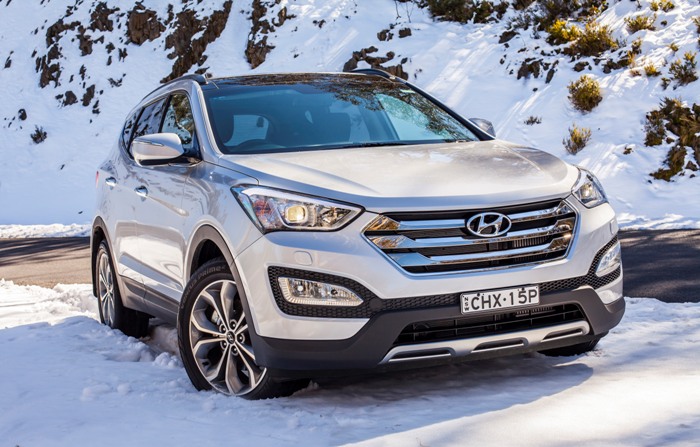
Car reviews
Read our expert car reviews - where we give insight into the latest vehicles to hit our roads.
03 May 2013
The new third generation Santa Fe has arrived and uses the company’s modern fluidic design language but with what Hyundai refer as a “Storm Edge” design concept. The large hexagon grille and the bigger body provide ample road presence and the sleek new sculptured body lines give it a premium quality visual appearance.

The SUV segment of the new car market shows no sign of relinquishing its position at the top of the sales leader board, and every mainstream importer has at least one on its price list. Hyundai is no stranger to this segment and has retailed the Santa Fe for over a decade. Last year alone it sold a substantial 1733 units.
The new third generation Santa Fe has arrived and uses the company’s modern fluidic design language but with what Hyundai refer as a “Storm Edge” design concept. The large hexagon grille and the bigger body provide ample road presence and the sleek new sculptured body lines give it a premium quality visual appearance.
The Santa Fe is offered with either five or seven seating positions and the cabin is in line with other recent Hyundai product, with good quality trim used throughout. The second row 40/20/40 split seat can slide forward to free up extra leg room for third row passengers or for loading bigger objects in the boot. The body size has increased in length as well as width and although the ride height has dropped by 10-12mm (depending on the model), there is adequate clearance for off road excursions.
Hyundai has successfully reduced the NVH levels by adding insulators, sound dampening material and an extra layer of laminating on the front windscreen. The vehicle’s structure has been strengthened with the use of high tensile steels to improve body rigidity, and there’s on average a 70kg reduction in weight, which helps to trim fuel consumption figures as well.
The foot operated parking brake is fitted to all but the Elite and Elite Limited models, which use an electrically operated type. The electric parking brake automatically releases when moving from a standstill or engages when the vehicle comes to a complete stop with the auto hold function activated. Another new feature on Santa Fe is the Flex Steer system that was introduced with the i30 hatchback last year. It allows drivers to customise the steering-wheel weight to one of three settings; the modes are comfort, normal and sport.
Hyundai introduced satellite navigation with SUNA traffic channel to a few models earlier in the year and now it’s offered on the Santa Fe. SUNA receives live traffic information and alerts the driver of congested roads and will redirect you to another route to avoid traffic jams.
The new model has retained the popular R-series diesel powerplant which was the biggest seller in 2012 and made up nine tenths of Santa Fe sales. The 2.2L engine produces a useful 145kW of power and 436Nm of torque, plus it’s frugal too with a claimed average fuel consumption of 7.3L/100km. The 2.4L GDI (Gasoline Direct Injection) motor produces a healthy 141kW of power while torque is a reasonable 242Nm and fuel is burnt at a rate of 9.0L/100km. The 3.3L V6 petrol engine has a decent 199kW of power and 318Nm of torque while fuel consumption is 9.6L/100km. All motors are mated to a smooth shifting six-speed automatic transmission although all but the V6 are AWD.
The AWD system distributes the torque between the front and rear wheels on demand. For off the black top driving you can select AWD lock for a 50:50 torque split, but under normal driving conditions the vehicle will predominantly be in 2WD mode.
Passive safety features include Brake Assist System (BAS), Electronic Stability Control (ESC), Traction Control System (TCS) and Vehicle Stability Management (VSM). Active safety features are in the form of seven airbags while second row outer seats have ISOFIX anchorage points. The vehicle is awarded a five-star ANCAP safety rating.
Standard specification is in the form of cloth seats, manually operated air conditioning while Elite models add electrically operated front seats, climate control air conditioning, leather seats, three-stage front seat warmers, two-stage second row seat warmers and satellite navigation. The Elite Limited adds HID Xenon headlights, LED rear tail lights, panoramic sunroof and rear window shades to name a few.
The price list starts with the 2.4L five seat option at $57,990 while an extra two seating positions add $2,000 to the price. The Elite retails for $67,990 and the only 2WD model with the 3.3L engine is stickered at $67,990. Pricing for diesel models start at $63,990 for a five seater, $65,990 for the seven seater and the Elite is stickered at $73,990, while the Elite Limited tops the scales at $79,990.
Hyundai can rely on the Santa Fe’s good look and proven oiler powerplant to lure drivers into showrooms, though the bold new price list which Hyundai refers to as “modest” due to the additional features, might be an obstacle for some buyers. Hyundai execs don’t expect to start selling the new model at the same record numbers seen in 2012 but estimate to sell around 1,200 units this year. Although another ad campaign like the run-out model’s free towbar special, appealing to the Kiwi outdoorsy lifestylers, might be enough to attract more shoppers.